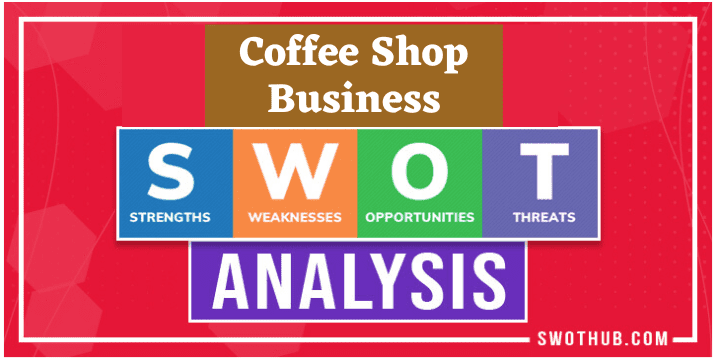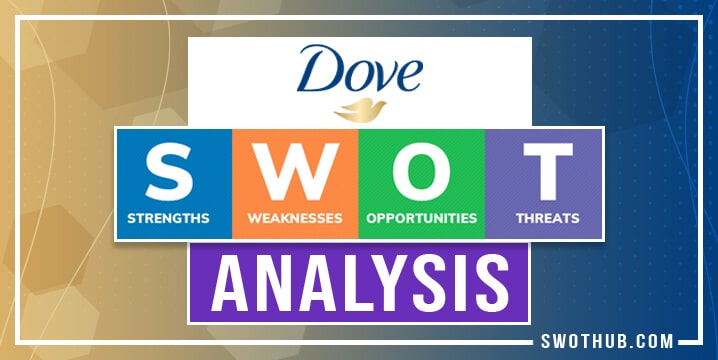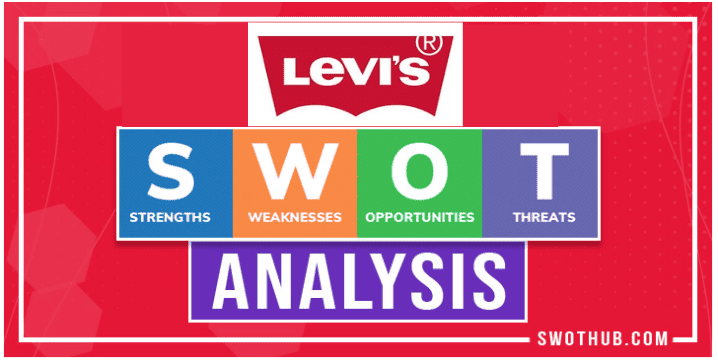For most of the world, drinking coffee is an essential part of a home, business, and social life. In this SWOT analysis of coffee shop, we will look at how the ‘java’ world has been transformed over the last twenty years. If you are considering starting a coffee shop or you are researching the profitability of the coffee shop business, this SWOT analysis will be helpful.
The coffee shop business has become a lucrative and competitive market for several reasons. First, coffee is a beverage that is consumed by a large number of people around the world, making it a high-demand product. Second, coffee shops often offer a cozy and inviting atmosphere where people can socialize, work, or relax. Finally, coffee shops typically have high-profit margins, as the cost of goods sold is relatively low compared to the price of the coffee.
What are Key Success Factors for a Coffee Shop?
There are several reasons why the coffee shop industry has grown in recent years. One reason is the increasing popularity of specialty coffee, which has led to a demand for higher quality and more unique coffee offerings. Another reason is the rise of remote work, which has led to an increase in demand for workspaces outside of the home. Coffee shops offer a convenient and comfortable place to work, meet clients, or hold meetings. Additionally, coffee shops have become a popular destination for socializing, as they often offer a welcoming and inclusive atmosphere.
Some examples of the growth of the coffee shop industry in the U.S. and around the world include:
Starbucks: Starbucks is the largest coffee chain in the world, with over 31,000 locations in 83 countries. The company has been successful in part because of its focus on offering high-quality coffee and creating a welcoming atmosphere for its customers.
Dunkin’: Dunkin’, formerly known as Dunkin’ Donuts, is another major player in the coffee shop industry. The company has over 13,000 locations in 41 countries and has expanded beyond its original focus on donuts to become a full-service coffee shop.
Third Wave Coffee: Third wave coffee refers to a movement that has emerged in recent years to focus on the quality and uniqueness of coffee. This movement has led to the growth of independent coffee shops that offer specialty coffee and unique brewing methods.
Asia-Pacific Region: The Asia-Pacific region has become a major growth market for the coffee shop industry in recent years. Countries like China, Japan, and South Korea have seen a significant increase in coffee consumption, which has led to the growth of local and international coffee chains.
Table of Contents
How to Easily Write a Coffee Shop Business Plan:
SWOT Analysis of Coffee Shop:
A SWOT analysis is a framework used to assess a company’s or industry’s competitive situation and to create strategic planning. Taking a SWOT Analysis of coffee shop strengths, weaknesses of SWOT Analysis of coffee shop threats, and opportunities of SWOT Analysis of coffee shop, we may better gain in-depth knowledge about coffee shops. In this article, we’ll be taking a look at SWOT Analysis of coffee shop framework to better understand its competitive position and potential for future growth. See how the SWOT Analysis of coffee shop competitors fare against them and learn about the strengths of a coffee shop, as well as weaknesses, opportunities, and threats of a coffee shop.
SWOT Analysis of Coffee Shop Strengths:
The areas where a company excels above average or in a manner that distinguishes it from its rivals are its strengths. SWOT Analysis of coffee shop strengths are outlined in this coffee shop SWOT analysis. Here are the strengths of a coffee shop that can set it above its competitors:
High-quality coffee and other products: The coffee shop may have a significant competitive advantage if it sells high-quality coffee, baked goods, and other items. Customers frequently base their decisions on a coffee shop’s taste and product quality, so if the coffee shop can set itself apart on this front, it will be able to draw in and keep customers.
Unique menu items: Offering unique and creative menu items can be a strength against competitors. This can include specialty drinks, seasonal items, or innovative food offerings. By offering something that other coffee shops don’t have, the coffee shop can attract customers who are looking for a different experience.
Convenient location: A coffee shop’s location in a convenient area, such as a crowded shopping area, office complex, or transportation hub, can give it a significant advantage over rivals. Customers frequently look for coffee shops that are convenient and simple to get to.
Comfortable and welcoming atmosphere: Creating a cozy and inviting atmosphere can be a strength against competitors. Customers often choose coffee shops based on the ambiance and atmosphere, so if the coffee shop can offer a comfortable and welcoming space, it can attract and retain customers.
What are the Strengths of a Coffee Shop?
Offering individualized customer service: In a SWOT Analysis of coffee shop this personalized service can give coffee companies an advantage over bigger coffee brands. If the coffee shop can provide this level of individualized service, it can build a loyal clientele because customers frequently appreciate it when baristas remember their names, favorite drinks, or other preferences.
Competitive pricing: Offering competitive pricing can be a strength against local coffee shops and larger coffee brands. If the coffee shop can offer similar quality products at a lower price point, it can attract customers who are looking for value.
Strong social media presence: Having a strong social media presence can be a strength against competitors. By showcasing the coffee shop’s products, atmosphere, and unique offerings on social media platforms, the coffee shop can attract new customers and create a loyal following.
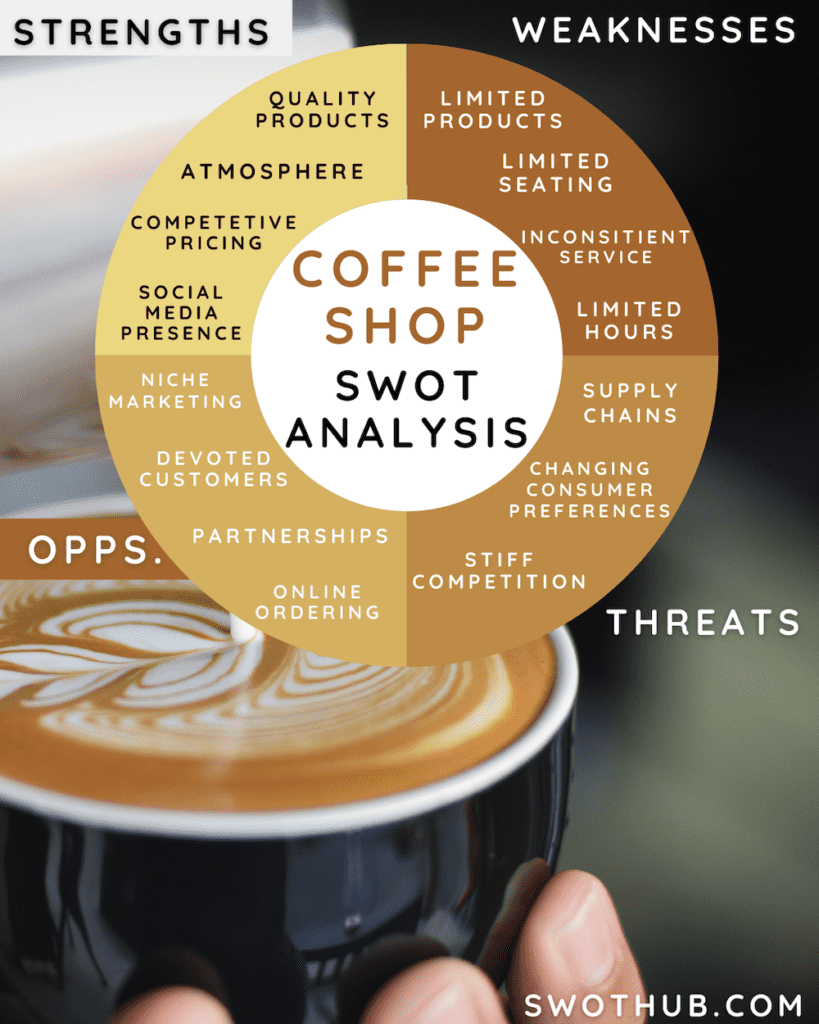
SWOT Analysis of Coffee Shop Weaknesses:
Weaknesses of a company are those that limit its potential, make it less competitive, and prevent it from achieving its goals. In this section of the SWOT analysis of coffee shop, we’ll look at a sample weakness of a coffee shop. In a SWOT analysis of a coffee business some of its weaknesses compared to coffee shop competitors include:
Limited resources: Compared to larger coffee brands, a smaller coffee shop may have limited resources in terms of marketing, hiring, and inventory. This can make it harder to compete on certain factors, such as advertising or product variety in this SWOT Analysis of coffee shop.
Narrow brand recognition: Compared to more seasoned neighborhood coffee shops or more well-known national coffee brands, a coffee shop may have limited brand recognition if it is relatively new or unknown. This may make it more difficult to draw in and keep customers, especially if the coffee shop is situated in an area with lots of rival businesses.
What is a sample weakness of a coffee shop?
Limited seating or space: If the coffee shop has limited seating or space, this can be a weakness against competitors that offer more spacious or comfortable environments. Customers may choose to visit other coffee shops if they can’t find a seat or if they feel cramped or uncomfortable.
Product inconsistencies or service quality: In a SWOT analysis of coffee shop poor service can make the coffee shop vulnerable to rivals. If a customer has a poor experience or feels that the quality or service is subpar, they may decide to go to another coffee shop.
Higher pricing: If the coffee shop has higher pricing compared to local coffee shops or larger coffee brands, this can be a weakness against competitors. Customers may choose to visit other coffee shops that offer similar products at a lower price point, particularly if they are price-sensitive.
Limited hours: If a coffee shop only operates during certain hours, this may put it at a disadvantage to rivals who maintain more flexible or longer hours. If a customer can’t make it to the coffee shop during business hours, they may opt to go to another one.
What are Weaknesses of Starbucks?
We conducted a Starbucks SWOT analysis here. Visit that post to take a look at Starbuck’s weaknesses along with Starbuck’s strengths.
…
Read the Starbucks SWOT analysis here.
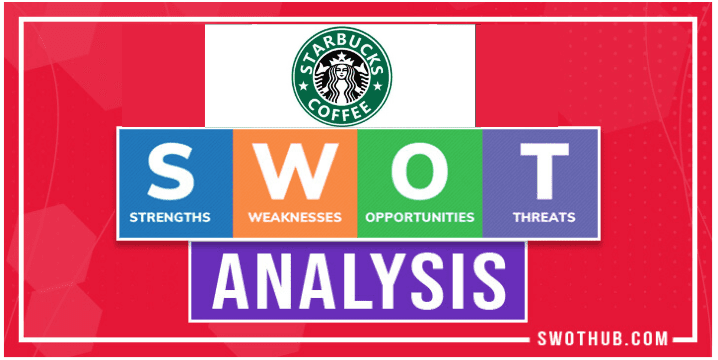
SWOT Analysis of Coffee Shop Opportunities:
There are always a variety of ways a coffee shop business can take advantage of the market, its customers, and the industry to improve their bottom line. The following portion of the coffee shop SWOT analysis will examine some coffee shop business opportunities compared to competitors including:
Expansion of products or services: If the coffee shop can expand its menu or product offerings, this can be an opportunity to attract new customers or retain existing ones. This can include offering new food items, specialty drinks, or merchandise.
Targeting a niche market: If the coffee shop can locate and cater to a particular niche market, this may present an opportunity to set itself apart from rivals. For instance, the coffee shop could provide options that are gluten-free or vegan for customers who have special dietary requirements.
Strategic partnerships: Partnering with other local businesses, such as bakeries or bookstores, can be an opportunity to attract new customers and create a unique experience. This can also help the coffee shop differentiate itself from competitors and create a sense of community.
Provide online ordering: If the coffee shop can provide online ordering and delivery services, this may be an opportunity to draw in customers who value accessibility and convenience. This can aid the coffee shop’s ability to compete with larger coffee brands that provide comparable services.
Marketing and branding: Investing in marketing and branding can be an opportunity to increase brand awareness and attract new customers. This can include social media marketing, influencer partnerships, or local advertising. We have found in a SWOT analysis of coffee shop that this can be the strongest opportunity of them all.
Expansion to new locations: If the coffee shop has been successful in its current location, expanding to new locations can be an opportunity to reach new customers and grow the business. This can also help the coffee shop compete with larger coffee brands that have multiple locations.
Developing a devoted customer base: can help a coffee shop stand out from rivals and develop a sustainable business model. Offering loyalty programs, specialized customer care, or distinctive experiences are a few examples of this.
Coffee Shop SWOT Analysis Threats:
Threats pose a risk to every company’s stability and profitability. This coffee shop SWOT analysis will address some of the threats and problems that a coffee shop business should examine.
Increased competition: The coffee shop may face increased competition from new local coffee shops or larger coffee brands entering the market. This can make it harder to attract and retain customers, particularly if the coffee shop is located in an area with many competitors.
Economic downturns: When the economy is struggling, customers’ discretionary spending on things like specialty coffee drinks may decline, which can be detrimental to the coffee shop industry. Reduced sales and revenue may result from this.
Changing consumer preferences: Changing consumer preferences can be a threat to the coffee shop industry, as customers may shift towards healthier options or prioritize sustainability. The coffee shop may need to adapt its menu or business practices to meet these changing preferences.
Supply chain hiccups: The coffee shop industry may be at risk from supply chain hiccups like shortages of coffee beans or price changes. Costs may rise as a result, and product quality may decline.
What are the problems in a coffee shop business?
External factors: External factors such as natural disasters, political instability, or pandemics can have a negative impact on the coffee shop industry. These factors can disrupt supply chains, decrease customer traffic, and impact overall revenue.
Legal and regulatory changes: Changes in laws or regulations, such as increases in minimum wage or health and safety regulations, can be a threat to the coffee shop industry. These changes can lead to increased costs and decreased profitability.
Negative reviews or publicity: The reputation and customer base of the coffee shop may be at risk due to negative reviews or publicity. As a result, there may be a drop in sales and revenue, as well as trouble luring in new clients.
Coffee Shop SWOT Analysis – Conclusion and Recommendations:
After conducting a thorough SWOT analysis of coffee shop, it is clear that there are several factors that can impact the success of the business in a competitive market.
- The coffee shop should focus on enhancing its unique value proposition by providing a memorable experience that cannot be found elsewhere. This can be achieved by offering quality coffee and food, exceptional customer service, and creating a welcoming environment that fosters a sense of community.
- The coffee shop can also invest in strategic partnerships with local businesses, offer convenient online ordering and delivery services, and expand its product offerings to attract new customers.
- The coffee shop business should focus on improving its operational efficiency and reducing costs. This can be achieved by streamlining its supply chain and inventory management processes, optimizing staffing levels, and investing in employee training to enhance productivity and performance.
- In this SWOT analysis of a coffee shop should focus on expanding its customer base and increasing its revenue streams. This can be achieved by targeting a niche market, investing in marketing and branding, and exploring new revenue streams such as catering or merchandise sales.
FAQs for SWOT Analysis of Coffee Shop
What are the strengths of a coffee shop?
*Cozy atmosphere and social space
*High demand for coffee and beverages
*Potential for repeat customers and loyalty programs
*Flexibility in menu offerings and pricing
*Opportunities for community engagement and events
What are the threats in the coffee shop business?
*Intense competition from established chains
*Fluctuating coffee bean prices affecting profit margins
*Changing consumer preferences and health concerns
*Challenges in attracting and retaining skilled baristas
What are the target market characteristics of a coffee shop?
*Predominantly young adults and working professionals
*Urban and suburban locations with foot traffic
*Preference for quality coffee and specialty beverages
*Interest in a trendy and comfortable ambiance
*Willingness to spend on premium coffee experiences
What type of business is best for a coffee shop?
*Independent coffee shop with a unique brand and atmosphere
*Specialty coffee roaster and retailer
*Coffee shop with a focus on artisanal and handcrafted beverages
*Hybrid coffee shop and coworking space
*Eco-friendly and sustainable coffee shop concept
By following these recommendations for the future of a coffee shop business the owners can achieve long-term growth and profitability in a competitive coffee shop market.

